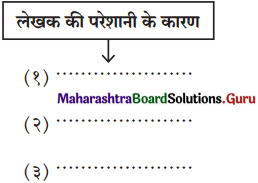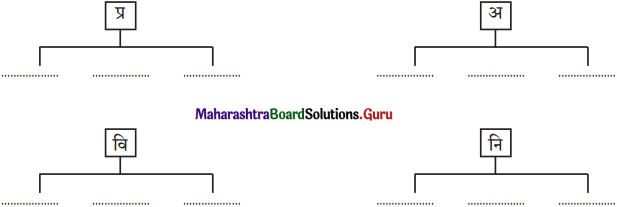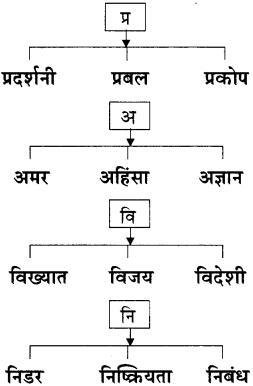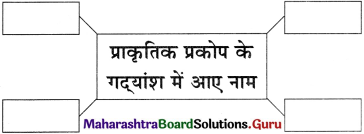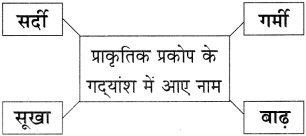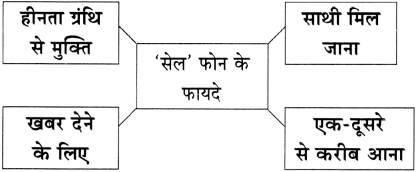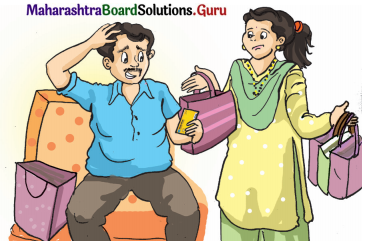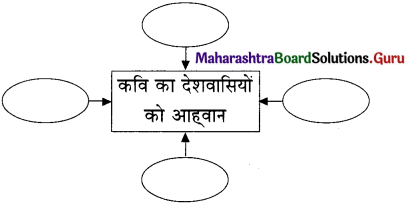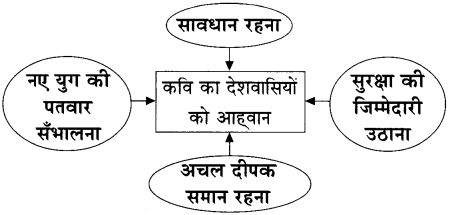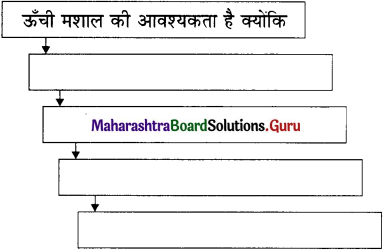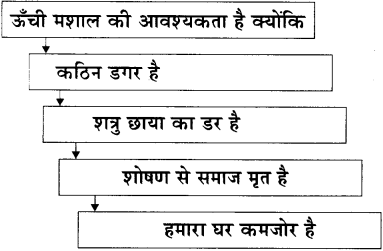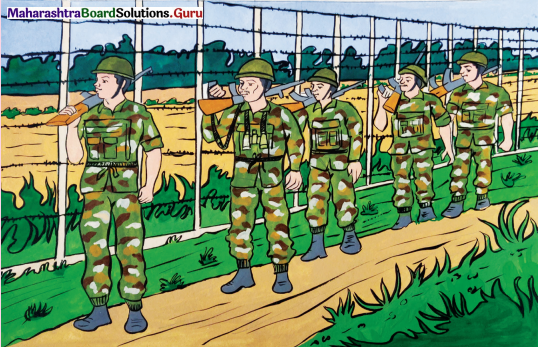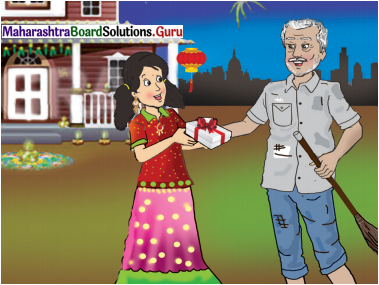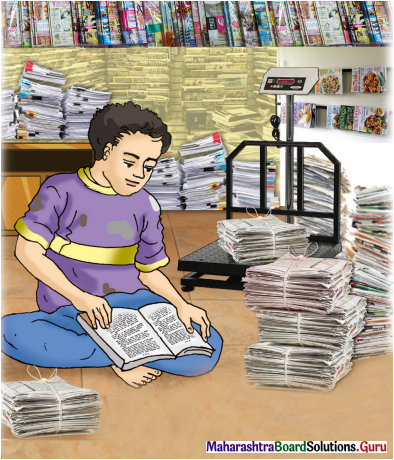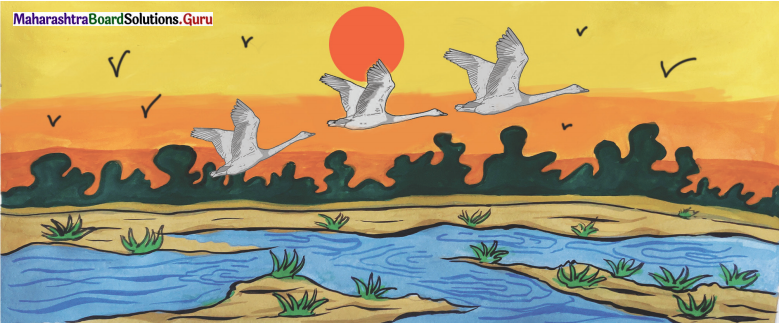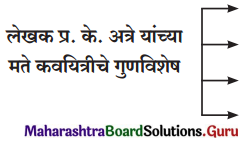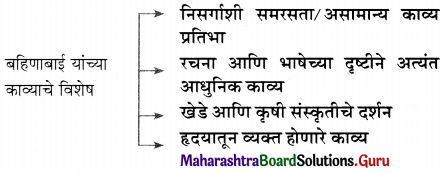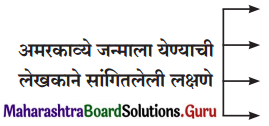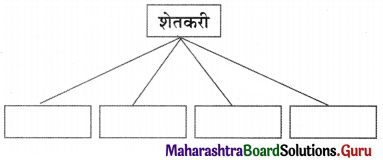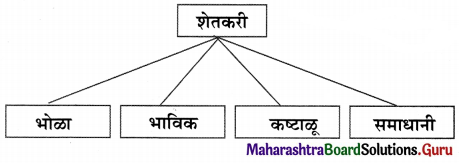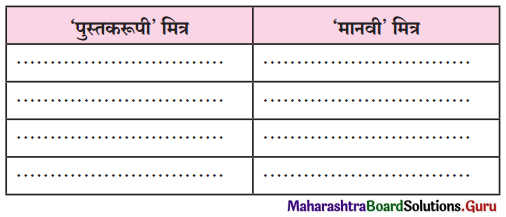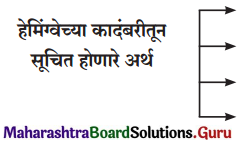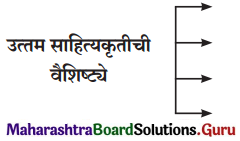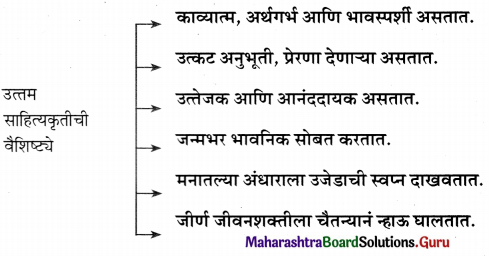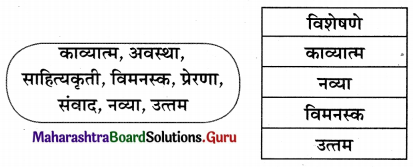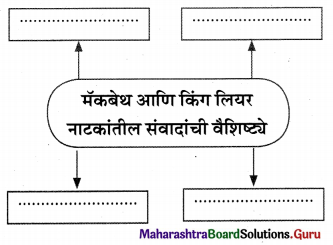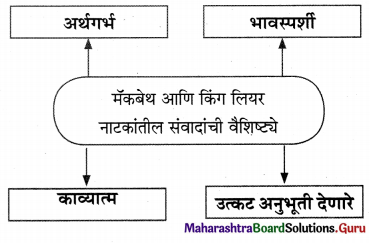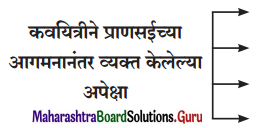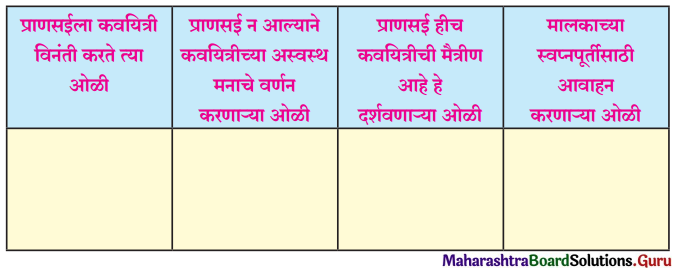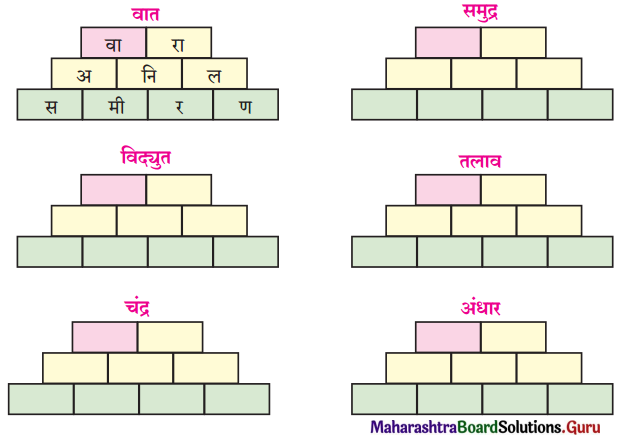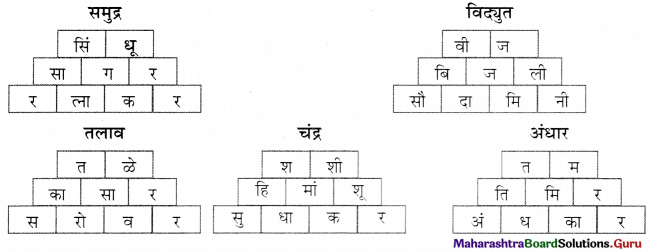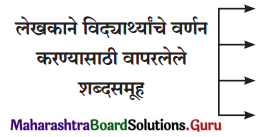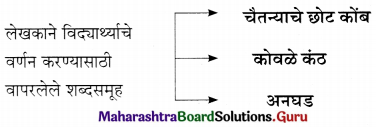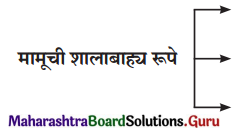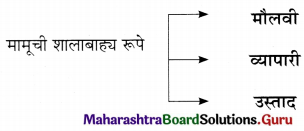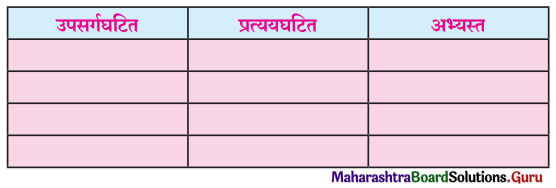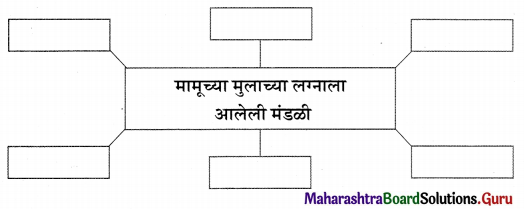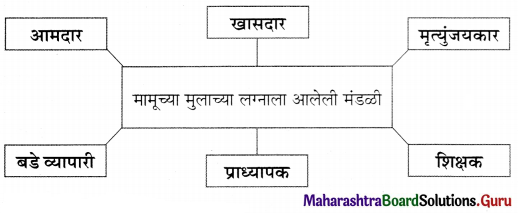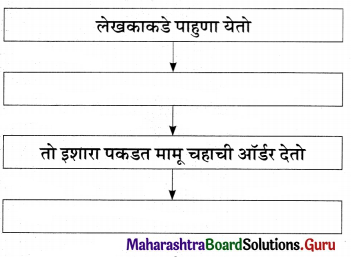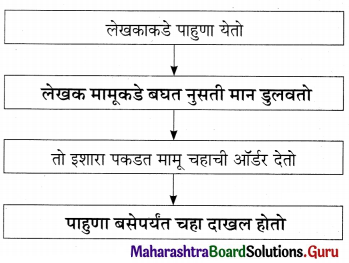Std 11 Hindi Chapter 5.1 Madhyayugin Kavya Bhakti Mahima Question Answer Maharashtra Board
Balbharti Maharashtra State Board Hindi Yuvakbharati 11th Digest Chapter 5.1 मध्ययुगीन काव्य (अ) भक्ति महिमा Notes, Textbook Exercise Important Questions and Answers.
Hindi Yuvakbharati 11th Digest Chapter 5.1 मध्ययुगीन काव्य (अ) भक्ति महिमा Questions And Answers
11th Hindi Digest Chapter 5.1 मध्ययुगीन काव्य (अ) भक्ति महिमा Textbook Questions and Answers
आकलन
1. सूचनाओं के अनुसार कृतियाँ पूर्ण कीजिए :
प्रश्न अ.
(a) अंतर स्पष्ट कीजिए –
माया रस – रामरस
……………………… – ………………………
उत्तर :
माया रस – राम रस
पत्थर जैसा हृदय – मक्खन जैसा हृदय
![]()
प्रश्न 2.
लिखिए –
‘मैं ही मुझको मारता’ से तात्पर्य ………………………
उत्तर :
मनुष्य स्वयं ही स्वयं का शत्रु है। अगर वह इस मैं (अहंकार) रूपी शत्रु को मार देता है तो वह इस संसार में विजेता हो जाता है।
प्रश्न आ.
सहसंबंध जोड़कर अर्थपूर्ण वाक्य बनाइए –
(1) पाती प्रेम की (2) साईं
(1) काहै को दुख दीजिए (2) बिरला
उत्तर :
(1) प्रेम की पाती कोई बिरला ही पढ़ पाता है।
(2) मूर्ख ! तू क्यों किसी को दुःख देता है, प्रभु तो सभी प्राणियों में निवास करता है।
काव्य सौंदर्य
2.
प्रश्न अ.
“जिनकी रख्या तूं करै ते उबरे करतार”, इस पंक्ति का भाव स्पष्ट कीजिए।
उत्तर :
हे परमात्मा जिस पर आपकी कृपा होती है वही इस भवसागर से पार हो पाता है। अन्य तो इस संसार के मायाजाल में फँसकर रह जाते हैं। अर्थात् मनुष्य जन्म दुर्लभ है और परमात्मा प्राप्ति मंजिल। सदैव मनुष्य को इस सत्य का ध्यान रखना चाहिए।
प्रश्न आ.
‘संत दादू के मतानुसार ईश्वर सबमें है’, इस आशय को व्यक्त करने वाली पंक्तियाँ ढूँढ़कर उनका भावार्थ स्पष्ट कीजिए।
उत्तर :
“काहै कौं दुख दीजिए, साईं है सब माहिं।
दादू एकै आत्मा, दूजा कोई नाहिं।।”
किसी भी प्राणी को किसी भी तरह का कष्ट, दुख, पीड़ा नहीं पहुँचानी चाहिए क्योंकि सभी प्राणी में वही परमात्मा निवास करता है जो हमारे मनुष्य जीवन का लक्ष्य है। हे जीव ! उस परमात्मा के अलावा वहाँ दूसरा कोई नहीं है। सबकी आत्मा एक है। कबीर दास जी भी यही कहते हैं –
“घट – घट में वही साईं रमता
कटुक वचन मत बोल रे”
अभिव्यक्ति
3.
प्रश्न अ.
‘अहंकार मनुष्य का सबसे बड़ा शत्रु हैं, इस उक्ति पर अपने विचार स्पष्ट कीजिए।
उत्तर :
अहंकार मनुष्य के लिए एक घातक बीमारी के समान है। यह ऐसा रोग है कि व्यक्ति को मेले में भी अकेला कर देता है। जिसके पास रहता है उसी का विनाश करता है। यह अहंकार मनुष्य के जीवन का लक्ष्य भटका देता है। इस लिए मनुष्य को सदा इससे सतर्क रहना चाहिए।
प्रश्न आ.
‘प्रेम और स्नेह मनुष्य जीवन का आधार हैं’, इस संदर्भ में अपना मत लिखिए।
उत्तर :
प्रेम ही जीव-जगत का सार है। अध्यात्मिक और भौतिक दोनों ही क्षेत्र में प्रेम और स्नेह दो ऐसे स्तंभ हैं जिनके सहारे मनुष्य अपना जीवन सार्थक कर सकता है। वेद-पुराण, इतिहास, श्रेष्ठ समाज यही कहता है कि जिसने प्रेम और स्नेह प्राप्त कर लिया उसने इस धरती पर ही अमृत का पान कर लिया।
![]()
रसास्वादन
प्रश्न 4.
ईश्वर भक्ति तथा प्रेम के आधार पर साखी के प्रथम छह पदों का रसास्वादन कीजिए।
उत्तर :
(i) शीर्षक : भक्ति महिमा
(ii) रचनाकार : संत दादू दयाल
(iii) केंद्रीय कल्पना : इन साखियों में कवि संत दादू दयाल जी ने ईश्वर भक्ति का मार्ग बताया है। ईश्वर को पूजने के लिए कहीं बाहर जाने की आवश्यकता नहीं है। ईश्वर मन के भीतर ही है। नामस्मरण करने से हमें मोक्ष प्राप्त होगा। वेद-पुराण पढ़ने से जीवन का सच्चा मार्ग नहीं मिलता बल्कि हृदय में जीवन और जगत के लिए प्रेम होना चाहिए यही कल्पना यहाँ कवि ने हमारे सामने रखी है।
(iv) रस-अलंकार : प्रस्तुत कविता नीति और ज्ञानोपदेश देने वाली साखियाँ हैं जो दोहा छंद में लिखी गई हैं।
(v) प्रतीक विधान : ईश्वर भक्ति, नामस्मरण, जीवन और जगत से प्रेम, अहंकार का त्याग करने से मोक्ष मिलेगा यही विधान कवि ने अपने दोहों में किया है।
(vi) कल्पना : संत दादू दयाल जी ने हृदय एक सँकरा महल है, ऐसी कल्पना की है और प्रभु और अहंकार दोनों उसमें एक साथ नहीं रह सकते ऐसा बताया है। अहंकार को त्यागने का संदेश देने के लिए कवि ने यह कल्पना की है।
(vii) पसंद की पंक्तियाँ तथा प्रभाव : इन साखियों में मेरी पसंदीदा साखी है –
‘जहाँ राम तहँ मैं नहीं, मैं तहँ नाहीं राम।
दादू महल बारीक है, वै कूँ नाही ठाम।।’
साखी का भाव दिल को छू लेता है और अहंकार को त्यागने का संदेश देता है। क्योंकि राम अर्थात ईश्वर और ‘मैं’ अर्थात अहंकार दोनों एक साथ नहीं रह सकते। मनुष्य का हृदय एक सँकरा महल है जहाँ अहंकार और ईश्वर एक साथ नहीं रह सकते। अहंकारी व्यक्ति ईश्वर से दूर हो जाता है। अत: अहंकार का त्याग कर के ही मनुष्य प्रभुमय हो सकता है। मनुष्य का बैरी उसका अहंकार है। है जो उसे प्रभु से मिलने नहीं देता। इसीलिए अहंकार का त्याग करना अनिवार्य है।
(viii) कविता पसंद आने के कारण : नीति ज्ञानोपदेश और संसार का व्यावहारिक ज्ञान देने वाली ये साखियाँ हैं जो हमें अहंकार को त्यागकर सभी को एक समान मानने की प्रेरणा देती हैं। इसीलिए मुझे यह कविता पसंद है। इनकी गेयता भी मुझे अच्छी लगती है।
![]()
साहित्य संबंधी सामान्य ज्ञान
5. जानकारी दीजिए :
प्रश्न अ.
निर्गुण शाखा के संत कवि –
उत्तर :
संत कबीर, कमाल, रैदास, धर्मदास, गुरुनानक, दादू दयाल, सुंदरदास, रज्जब, मलूकदास।
प्रश्न आ.
संत दादू के साहित्यिक जीवन का मुख्य लक्ष्य
उत्तर :
संत परंपरा के अनुसार दादू दयाल की रचनाओं में जात-पाँत का निराकरण, छोटा-बड़ा, अमीर-गरीब, हिंदु-मुसलमानों की एकता आदि विषयों पर विचार मिलते हैं। संत दादू के साहित्यिक पद तर्क-प्रेरित न होकर हृदय-प्रेरित हैं।
6. निम्नलिखित वाक्य शुद्ध करके फिर से लिखिए –
प्रश्न 1.
बाबु साहब ईश्वर के लिए मुझ पे दया कीजिए।
उत्तर :
बाबू साहब ईश्वर के लिए मुझपर दया कीजिए।
प्रश्न 2.
उसे तो मछुवे पर दया करना चाहिए था।
उत्तर :
उसे तो मछुवे पर दया करनी चाहिए थी।
प्रश्न 3.
उसे तुम्हारे शक्ती पर विश्वास हो गया।
उत्तर :
उसे तुम्हारी शक्ति पर विश्वास हो गया।
प्रश्न 4.
वह निर्भीक व्यक्ती देश में सुधार करता घूमता था।
उत्तर :
वह निर्भीक व्यक्ति देश में सुधार करते घूमता था।
प्रश्न 5.
मल्लिका ने देखी तो आँखें फटी रह गया।
उत्तर :
मल्लिका ने देखा तो आँखें फटी रह गई।
प्रश्न 6.
यहाँ तक पहुँचते-पहुँचते मार्च पर भारा अप्रैल लग जायेगी।
उत्तर :
यहाँ तक पहुँचते-पहुँचते मार्च तो क्या बारह अप्रैल लग जाएगा।
![]()
प्रश्न 7.
हमारा तो सबसे प्रीती है।
उत्तर :
हमारी तो सबसे प्रीति है।
प्रश्न 8.
तुम जूठे साबित होगा।
उत्तर :
तुम झूठे साबित होंगे।
प्रश्न 9.
तूम ने दीपक जेब में क्यों रख लिया?
उत्तर :
तुमने दीपक जेब में क्यों रख लिए?
प्रश्न 10.
इसकी काम आएगा।
उत्तर :
इसके काम आएगा।
Yuvakbharati Hindi 11th Textbook Solutions Chapter 5.1 मध्ययुगीन काव्य (अ) भक्ति महिमा Additional Important Questions and Answers
कृतिपत्रिका
(अ) निम्नलिखित पद्यांश पढ़कर दी गई सूचनाओं के अनुसार कृतियाँ कीजिए :
| पद्यांश : माखण मन ……………………………………………….. प्रेम बिना क्या होइ। (पाठ्यपुस्तक पृष्ठ क्र. 20) |
प्रश्न 1.
(i) चौखट में उत्तर लिखिए :

उत्तर :


उत्तर :
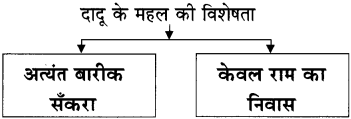
![]()
प्रश्न 2.
कारण लिखिए :
(i) अहंकार का त्याग करना अनिवार्य है –
उत्तर :
अहंकार का त्याग करना अनिवार्य है क्योंकि हृदय रूपी सँकरे (narrow) महल में प्रभु और अहंकार का एक साथ वास नहीं हो सकता।
(ii) प्रभु स्मरण के सिवा अन्य मार्ग दुगर्म हैं –
उत्तर :
प्रभु स्मरण के सिवा अन्य मार्ग दुर्गम हैं क्योंकि भक्ति का संबल (support) लेकर ही भवसागर आसानी से पार किया जा सकता है और अन्य मार्ग डूबो देते हैं।
प्रश्न 3.
प्रस्तुत पद्यांश का भावार्थ अपने शब्दों में लिखिए :
उत्तर :
मनुष्य जीवन में एक रामरस ही सार्थक होता है।
अन्य तो भवसागर में डुबोने वाला ही होता है। राम की प्राप्ति केवल प्रेम की नाव पर ही बैठकर प्राप्त हो सकती है। अहंकार मनुष्य का सबसे बड़ा शत्रु है। भक्ति के सहारे ही भवसागर पार किया जा सकता है। जीवन के उद्धार के लिए अन्य सभी मार्ग दुर्गम हैं।
प्रेम की पत्री वही पढ़ सकता है जिसके हृदय में प्रेम है। यदि हृदय में जीवन और जगत के लिए प्रेम नहीं तो वेद-पुराण आदि पुस्तकें पढ़ने से क्या लाभ?
(आ) निम्नलिखित पद्यांश पढ़कर दी गई सूचनाओं के अनुसार कृतियाँ कीजिए :
| पद्यांश : कागद काले करि मुए, ……………………………………………….. इनका मोल न तोल।। (पाठ्यपुस्तक पृष्ठ क्र. 20) |
प्रश्न 1.
परिणाम लिखिए :
(i) प्रभु का एक अक्षर पढ़ने का परिणाम –
उत्तर :
प्रभु का एक अक्षर पढ़ने का परिणाम – वह सुजान हो गया।
(ii) वेद-पुराण का गहन अध्ययन करने का परिणाम –
उत्तर :
वेद-पुराण का गहन अध्ययन करने का परिणाम – कागज़ काले हुए लेकिन जीवन का सच्चा मार्ग नहीं मिला।
प्रश्न 2.
लिखिए :

उत्तर :

![]()
(आ) उत्तर लिखिए :
(i) मेरा बैरी – …………………………………
(ii) सब में बसा है – …………………………………
उत्तर :
(i) अहंकार
(ii) साईं / ईश्वर / परमात्मा
प्रश्न 3.
पद्यांश की प्रथम दो साखियों का भावार्थ लिखिए :
उत्तर :
संत दादू दयाल जी अपनी साखियों में प्रभु के नामस्मरण का महत्त्व समझा रहे हैं। वे कहते हैं कि कितने ही लोगों ने वेद-पुरानों का गहन अध्ययन किया और उनकी व्याख्या करते हुए कागज काले किए, ग्रंथ लिख दिए। परंतु उन्हें जीवन का सच्चा मार्ग नहीं मिला। वे भवसागर में भटकते रहे।
जिसने प्रिय प्रभु का एक अक्षर ही पढ़ लिया, वह सुजान पंडित हो गया। मनुष्य को उसका अहंकार ही मारता है, दूसरा कोई नहीं। अहंकार का त्याग करने पर ही ईश्वर की प्राप्ति होती है। अपने अहंकार को मारकर ही मनुष्य मरजीवा हो सकता है अर्थात वैरागी बन सकता है।
अपने लौकिक बंधन तोड़कर स्वयं पर जीत पा सकता है। अहंकार के आवरण से बाहर निकलकर ही जीवन की सार्थकता मनुष्य समझ पाएगा।
मध्ययुगीन काव्य (अ) भक्ति महिमा Summary in Hindi
मध्ययुगीन काव्य (अ) भक्ति महिमा कवि परिचय :
संत दादू दयाल का जन्म 1544 को अहमदाबाद (गुजरात) में हुआ। आपके गुरु का नाम बुड्ढन था। आपने जिस संप्रदाय की स्थापना की वह ‘दादू पंथ’ के नाम से विख्यात हुआ संत परंपरा के अनुसार आपका दृष्टिकोण भी – “सर्वे भवंतु सुखिन:’ का रहा है।
समाज में व्याप्त सामाजिक कुरीतियाँ, अंधविश्वास और जातिगत ऊँच-नीच के विरोध में आपकी साखियाँ (एक काव्य प्रकार) एवं पद प्रस्तुत हैं।
आपके पद समाज, समता एवं एकता के पक्ष में हैं। आपने कबीर की भाँति अपने उपास्य को निर्गुण और निराकार (formless) माना है। संत दादू दयाल की मृत्यु-1603 में हुई।
![]()
प्रमुख रचनाएँ :
‘अनभैवाणी’, ‘कायाबेलि’ आदि।
मध्ययुगीन काव्य (अ) भक्ति महिमा काव्य विधा :
‘साखी’ साक्षी का अपभ्रंश है जो वस्तुतः दोहा छंद में ही लिखी जाती है। साखी का अर्थ है – साक्ष्य, प्रत्यक्ष ज्ञान। निर्गुण संत संप्रदाय का अधिकांश साहित्य साखी में ही लिखा गया है। जिसमें गुरुभक्ति और ज्ञान उपदेशों का समावेश है।
मध्ययुगीन काव्य (अ) भक्ति महिमा विषय प्रवेश :
प्रस्तुत साखी में संत कवि ने गुरु महिमा का वर्णन किया है। ईश्वर पूजन के लिए बाह्य संसाधन (exterior resources) की आवश्यकता नहीं है। ईश्वर के अलावा सांसारिक अंधकार को दूर करने वाला अन्य कोई नहीं है। नाम स्मरण से पत्थर हृदय भी मक्खन सा मुलायम हो जाता है।
अंहकार मनुष्य का सबसे बड़ा शत्रु है। बिना इसका त्याग किए ईश्वर की प्राप्ति नहीं हो सकती। जिसकी रक्षा ईश्वर करता है, वही इस भवसागर से पार हो सकता है। ईश्वर एक ही है और वही एक ईश्वर सभी प्राणियों में समान रूप से निवास करता है अर्थात् सभी को एक समान मानना चाहिए।
मध्ययुगीन काव्य (अ) भक्ति महिमा सारांश (कविता का भावार्थ) :
मायामोह में रहने वाले व्यक्ति का हृदय पत्थर के समान हो जाता है। ईश्वर भक्ति में लीन रहने वाले मनुष्य का हृदय ईश्वर प्रेम से भरा रहता है। मनुष्य को सदा अहंकार से दूर रहना चाहिए। प्रभु प्राप्ति में अहंकार बहुत बड़ी बाधा है। ईश्वर कीर्तन में दादू मग्न हो जाते हैं। उनको ऐसा लगता है कि उनके मुँह से ताल (rhythm) बजने की आवाज आ रही है, उनके प्रभु उनके समक्ष प्रस्तुत है।
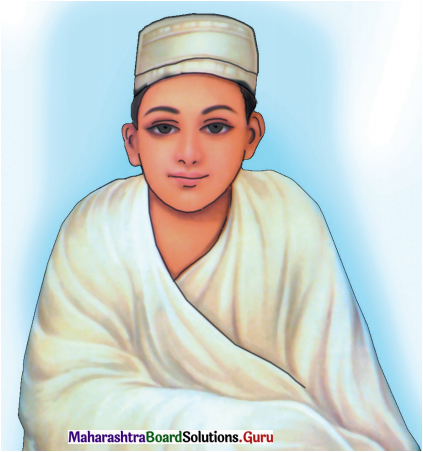
भक्ति के सहारे ही संसार को पार किया जा सकता है। प्रभु स्मरण के अतिरिक्त संसार पार के अन्य मार्ग केवल भ्रम है। प्रेम ही जीवन और संसार का सार है। प्रेम नहीं तो संपूर्ण वेद वेदांत का अध्ययन निर्रथक है। वेद पुराण की व्याख्या करने वाले जाने कितने लोगों ने कितने कागज़ भर डाले पर प्रभु का सानिध्य (nearness) नहीं मिल पाया। जिसने प्रभु प्रेम का अक्षर आत्मसात कर लिया वह पंडित हो गया। अहंकार ही मनुष्य का सबसे बड़ा शत्रु है।
![]()
जिसने अहंकार पर विजय प्राप्त कर लिया वह विजेता हो जाता है। परमात्मा जिसका हाथ पकड़ लेता है वही इस संसार रूपी सागर से पार हो सकता है। शेष तो भवसागर में डूब ही मरते हैं। सज्जन व्यक्ति ही प्रभु कृपा का पात्र होता है।
आत्मा में ही परमात्मा का निवास होता है इसलिए किसी को भी किसी तरह का कष्ट, दुःख मत पहुँचाना।
इस संसार में दो ही ऐसे रत्न हैं जिनकी किसी से भी कोई तुलना नहीं है। पहला रत्न है – सबका मालिक, स्वामी, प्रभु, परमात्मा और दूसरा रत्न है – संकीर्तन करने वाला संतजन। इन्हीं दो रत्नों के बल पर, सामर्थ्य पर जीवन और जगत सुंदर बन जाता है। ये दोनों ही रत्न ऐसे हैं जिनका मोल-तोल नहीं हो सकता।
मध्ययुगीन काव्य (अ) भक्ति महिमा शब्दार्थ :
- माखण = मक्खन (butter),
- पाहण = पत्थर (stone),
- मैं = अहंकार (ego),
- बारीक = सँकरा (narrow),
- द्वै = दोनों (माया और राम) (both),
- ठाम = स्थान, जगह (place),
- सुरति = याद, स्मरण (memory),
- दीनदयाल = परमात्मा (god),
- बाँचे = पढ़ना (to read),
- केते = कितने, बहुत (many),
- एकै = एक ही (only one),
- आखर = अक्षर (letter),
- सुजान = चतुर, विद्वान (clever),
- बैरी = शत्रु (enemy),

- मरजीवा = जीवित होते हुए भी मरा हुआ, वैरागी (hermit),
- रढया = रक्षा करना (protect, save),
- करतार = सृष्टिकर्ता (god),
- संसार = माया, मोह (world),
- अमोल = जिसका कोई मोल न हो, अनमोल, अमूल्य। (priceless)
- पाहण = पत्थर
- सुरति = याद, स्मरण
- बाँचे = पढ़ना
- मरजीवा = जीवित होते हुए भी मरा हुआ, वैरागी
- करतार = सृष्टिकर्ता
- रख्या = रक्षा करना
Hindi Yuvakbharati 11th Digest Text Book Solutions
- प्रेरणा Class 11 Hindi Textbook Solutions
- लघु कथाएँ (अ) उषा की दीपावली (आ) मुस्कु राती चोट Class 11 Hindi Textbook Solutions
- पंद्रह अगस्त Class 11 Hindi Textbook Solutions
- मेरा भला करने वालों से बचाएँ Class 11 Hindi Textbook Solutions
- मध्ययुगीन काव्य (अ) भक्ति महिमा Class 11 Hindi Textbook Solutions
- मध्ययुगीन काव्य (आ) बाल लीला Class 11 Hindi Textbook Solutions
- कलम का सिपाही Class 11 Hindi Textbook Solutions
- स्वागत है! Class 11 Hindi Textbook Solutions
- तत्सत Class 11 Hindi Textbook Solutions
- गजलें (अ) दोस्ती (आ) मौजूद Class 11 Hindi Textbook Solutions
- महत्त्वाकांक्षा और लोभ Class 11 Hindi Textbook Solutions
- भारती का सपूत Class 11 Hindi Textbook Solutions
- सहर्ष स्वीकारा है Class 11 Hindi Textbook Solutions
